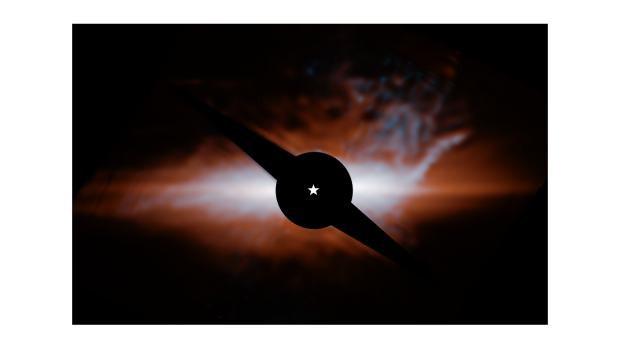JWST Captures Galactic ‘Cat’s Tail’ in the Beta Pictoris System
Beta Pictoris, a star of 4th magnitude located approximately 63 light-years away from Earth, has once again amazed scientists. It is already renowned for being the first star to harbor a dusty disk of debris, which was later revealed to be multiple disks. However, recent observations made by the James Webb Space Telescope (JWST) have unveiled a previously unseen feature: a dusty offshoot resembling the curled tail of a cat. This structure is situated on Beta Pictoris’ secondary disk, which is inclined in comparison to the initial disk that astronomers initially detected in the 1980s.
Isabel Rebollido, the lead author of the study from the Astrobiology Center in Madrid, Spain, stated, “Beta Pictoris is the debris disk that possesses a multitude of fascinating elements: a brilliantly bright star in close proximity that we can thoroughly examine, and a complex circumstellar environment consisting of a multi-component disk, exocomets, and two imaged exoplanets. Previous ground-based observations in this wavelength range lacked the sensitivity and spatial resolution that we now possess with Webb, thus failing to detect this feature.”
The discovery has been accepted for publication in the Astronomical Journal and is accessible on the preprint server arXiv. Additionally, the team presented their findings at the 243rd American Astronomical Society Meeting in New Orleans earlier this month.
How was the feature found?
In 1983, astronomers initially observed an abundance of infrared radiation emanating from the Beta Pictoris system, indicating the presence of a dusty disk surrounding the star. A year later, the system was imaged, providing visual evidence of the disk. Subsequently, in 2006, the Hubble Space Telescope validated the presence of two disks encircling the star. Within these disks, two exoplanets have been identified: Beta Pictoris b and c.
The star was observed by JWST using both its NIRcam and MIRI instrument. The findings indicated that the second disk of Beta Pictoris and its dusty tail are both of higher temperature compared to its primary disk. However, it is important to note that the term “hot” is relative in this context. These features are not visible at visible wavelengths but emit a glow when observed in mid-infrared. Based on the press release, researchers speculate that the higher temperature may be attributed to the presence of “organic refractory material” in the dust, which includes carbon-rich molecules commonly found in comets and asteroids. This is similar to the debris collected from the asteroid Bennu, which bears resemblance to the material detected by MIRI around Beta Pictoris.
What formed the cat’s tail?
Researchers are still uncertain about the origin of the tail, as they have not observed similar structures in the dust disks surrounding other stars. By examining it, they have determined that the tail contains a significant amount of dust, spread out over a vast distance of 10 billion miles (16 billion kilometers).
The question remains: how did this tail form? Through the use of a computer model, the team proposes that a collision event that occurred a century ago could have shaped the tail.
According to Marshall Perrin, an astronomer at the Space Telescope Science Institute in Baltimore and co-author of the study, the dust initially follows the same orbital path as its source. However, it gradually disperses due to the influence of the star’s light. The smaller and lighter dust particles are pushed away from the star at a faster rate, while the larger grains experience less movement. This differential motion results in the formation of a long, tendril-like tail.
Regarding the distinct shape of the tail, the team’s model, along with others, suggests that it is an optical illusion. Despite the dust being inclined at a mere 5° relative to the disk, its curved structure, combined with our unique line of sight from Earth, creates the feline-like feature that we observe.
This article is republished from astronomy.com under a Creative Commons license. Read the original article.
Do not forget to share your opinion with us to provide you with the best posts !




0 Comments